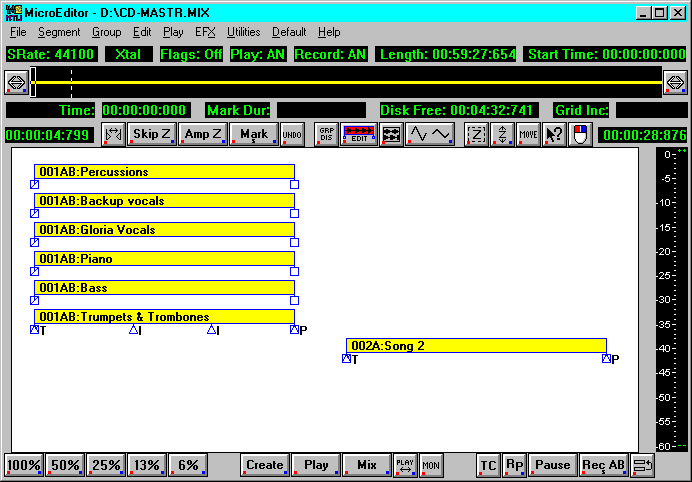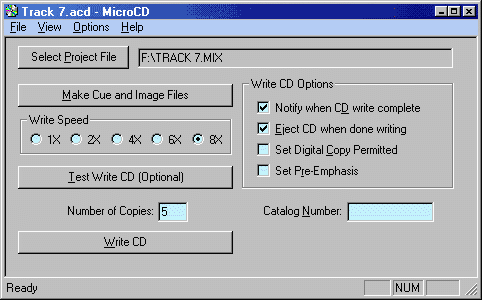The Original and Still #1
Karaoke Software!
New Year Specials!
All Software on Sale!
30% Off ALL Software!
Coupon Code: NEWYR26
| Microsound Workstation | Microeditor Software | Krystal DSP | DSP56K | IO Module | Microsync Card | Microtools SW | MicroCD SW | Forums |
MicroCD Audio CD Mastering Software
| Updated 07/06/06 |
Now you can create perfect Audio CD pre-production masters with ease with MicroCD and a Microeditor digital audio workstation. You will create professional Audio CDs every time because you can hear exactly the way the final Audio CD master will play; no guessing!
Beginners and skilled professionals alike create their first audio CD master in minutes because MicroCD does all the tech work for you. Click here and read how users since 1992 tell how easy it is to use.

You simply create a Microeditor project with master 16-bit and/or 24-bit audio segments for each track. Where they are placed determines when they play on the CD, and you can instantly move them. Adjusting the space between them sets the silence gaps for the audio CD. Overlapping them even allows crossfading from one to the next. Note: MicroCD requires Microeditor to operate.
Segments can either be premixed songs, or bring in multiple segments and overlap to mix your masters right in the project! You can instantly adjust the gain of each segment in the mix, easier than on a console. The image below shows examples for two songs. You can assign segments to groups (001 shown below) to move together as a single song, allowing you to rearrange the playing order.
The required audio CD mastering PQ codes tell the CD-Recorder how to write the audio CD image. In MicroCD and Microsound, these codes are set as 3 graphical flags that move with the segments. The flag name determines which code it is:
| Flag Name | Type | Description |
| T | Track ID | Track ID codes set where the track ID counter increments with up to 99 on a CD. You can place these anywhere. You can even insert multiple IDs within an audio segment, such as a 30-minute symphony with multiple movements, or a speech with different points you desire to index. |
| P | Pre-countdown | This optional code determines when the track ID counter begins a negative count down (-:03,-:02, -:01) before the next track starts. They belong before a track T-flag, and can even be placed inside a song, not just at the start. The distance it is in front of the following track flag determines the starting countdown value (3 seconds to the left starts at -:03). This does not change the audio or create silence gaps. |
| I | sub-Indexes | These optional codes can be set within a track to set Index IDs within the tracks. However, most CD Players do not show Index IDs. Each track can have up to 98 indices. |
MicroCD Software Screen

Once you have created the Microeditor project file, open it into MicroCD. Clicking the Make Cue and Image Files button creates these files with the PQ code list and the audio for the Audio CD master. You can select the CD-Recorder writing speed as you desire. The Test Write CD button tests the hardware and software without writing the media. The Write CD button writes the CD as a single session, disk-at-once, standard 16-bit red book Audio CD master. Projects with 24-bit samples automatically dither to 16-bits with sonic perfection. The resulting red book Audio CD master can be used as a pre-production CD master or in any audio CD player that accepts CDR media.
MicroCD Software Versions
V2.405
Released October 28, 2003- New Plextor drives are now supported including 2 new DVD burners: Plextor PX-W5224TA, Plextor PX-Premium, Plextor PX-W 504A (DVD), Plextor PX-W 708A (DVD) and Plextor PX-W 708UF (DVD). NOTE: Other new drives may be supported, but these are the only ones that we have tested.
- Installation Program now installs ASPI Drivers needed for MicroCD to run.
- Requires MicroEditor 5.4 or Higher + Krystal DSP card
V2.403
Released May 15, 2002- Now Supports 40x CD-Recorders
- Write Speed now supports up to 32x
- Added Underrun Protection Option as a button on the screen (Ctrl+U hot key), and in the Options menu (Write CD Options and check Underrun Protection). It enables the new Burn-Proof technology if your CD Burner supports it (current MTU CD Burners do).
- New Installation Program creates a Desktop Icon to run MicroCD
- Requires MicroEditor 5.3 or Higher + Krystal DSP card
V2.402
Released December 15, 2001- Supports 24x CD-Recorders - It can write at up to 12x speed, but not faster
- Requires MicroEditor 5.3 or Higher + Krystal DSP card
V2.401
Released May 20, 2001- Supports 16x CD-Recorders - It now writes up to 12x speed.
- Windows 98, ME, 2000 - It should run under Microsoft Windows 98SE, ME, 2000 and XP (note that Microeditor 5.400 does not run under 2000 or XP).
- Requires MicroEditor 5.3 or Higher + Krystal DSP card
V2.4
Released January 10, 2001- Supports IDE CD-Recorders - It now supports IDE CD-Recorders, and writes up to 12x speed.
- Requires MicroEditor 5.3 or Higher + Krystal DSP card
V2.3b
Released January 19, 2000- Supports new drives - It now runs the current CD-Recorders
- Requires MicroEditor 5.1b or higher
V2.3
Released January 13, 1999- 16-Bit or 24-Bit Projects - It can open 16- or 24-bit Microeditor projects. Since CD-DA media is written with 16-bit samples, MicroCD automatically dithers 24-bit samples down to 16-bits for the highest sonic clarity.
- Media Catalog Number - A new Catalog Number field has been added to the screen. If this optional entry is present, it is added to the CD.
- Windows 98, NT - It now runs under Microsoft Windows NT.
- Requires MicroEditor 5.1b or higher
V2.2
Released September 15, 1998- Handles Larger Project Sizes - This handles the new large project format that occurs automatically in Microeditor 5.1 and higher when very large projects are created. Earlier versions of MicroCD would not handle the large project format.
- Controls New CD-Recorders
- Windows 95 or 98 - It is now a 32-bit application running under Microsoft's 32-bit Windows 95 or 98.
- Requires MicroEditor 5.1b or higher
V2.1d
Released February 4, 1998- Installs CTL3D.DLL - The setup disk installs this required program.
- Controls New CD-Recorders - The Yamaha CRW2260, CRW4260 rewritable media recorders are supported.
- Windows 3.1x, 95 or 98 - It is a 16-bit application.
- Requires MicroEditor 5.0 and higher
V2.1c
Released October 27, 1997- Installs CTL3D.DLL - The install disk creates a sub directory on the hard drive with the MicroCD programs and installs the CTL3D.DLL program in the Windows SYSTEM directory. This runs with Microeditor 5.0 and higher.
- Controls New CD-Recorders
- Windows 3.1x, 95 or 98 - It is a 16-bit application.
- Requires MicroEditor 5.0 and higher
V2.1b
Released April 28, 1997- Requires CTL3D.DLL - The CTL3D.DLL program must be in the Windows SYSTEM directory installed by Microeditor 2.6 or 2.7, but not 5.0 and higher.
- Controls New SCSI CD-Recorders
- Windows 3.1x, 95 or 98 - It is a 16-bit application.
- Requires MicroEditor 2.6 to 2.7b
V2.1a
Released March 10, 1997- Requires CTL3D.DLL - The install disk creates a sub directory on the hard drive with the MicroCD programs. The CTL3D.DLL program must be in the Windows SYSTEM directory, installed by Microeditor 2.6 or 2.7.
- Controls New SCSI CD-Recorders
- Windows 3.1x, 95 or 98 - It is a 16-bit application.
- Requires MicroEditor 2.6 to 2.7b
V2.1
Released 1996- Requires CTL3D.DLL - V2.1 requires Microeditor 2.6 and higher to run. This upgrade was required as part of MTU's migration of Microeditor V5.0 to Windows 95 and NT. It is now easier to use than before with new screen buttons and click boxes for most functions.
- Segment Flags - These can now be used for PQ coding. Since these move when the segment order shuffles. Project flags can still be used, even mixed with segment flags.
- Cue Sheet Report - This is desired by CD replicators. It is now created in a .DOC file that is editable and printable. This allows entering ISRC codes for each Track and a Catalog code for the CD.
- Controls New SCSI CD-Recorders
- Windows 3.1x, 95 or 98 - It is a 16-bit application.
- Requires MicroEditor 2.6 to 2.7b
V2.0
Released 1995- Requires CTL3D.DLL - This upgrade was required as part of MTU's migration of Microeditor V5.0 to Windows 95 and NT. It is now easier to use than before with new screen buttons and click boxes for most functions. It requires Microeditor 2.6 to 2.7b to run as it installs the CTL3D.DLL file.
- Controls SCSI CD-Recorders
- Windows 3.1x - It is a 16-bit application.
- Requires MicroEditor 2.4a to V2.5d
V1.0
Released 1992- Yep, we did it back then - We controlled a Denon 1x CDR via their external control interface. The Denon cost $16,000 (Yamaha was $25,000).
- Windows 3.1x - It is a 16-bit application.
- Requires MicroEditor 2.2
